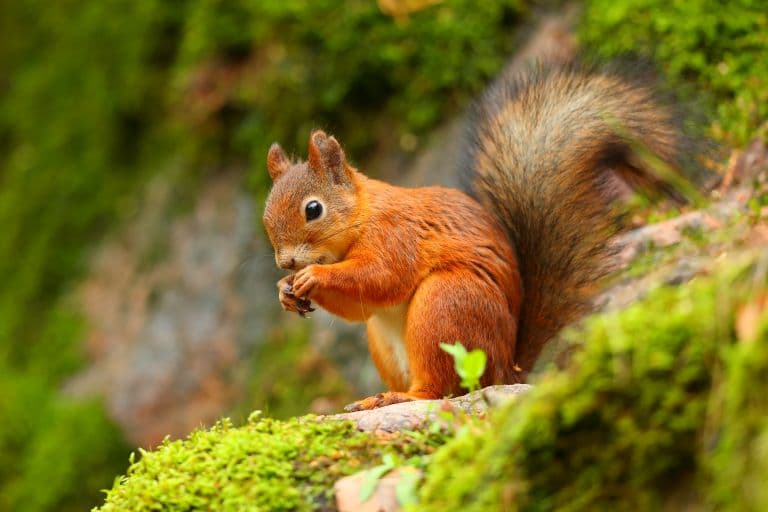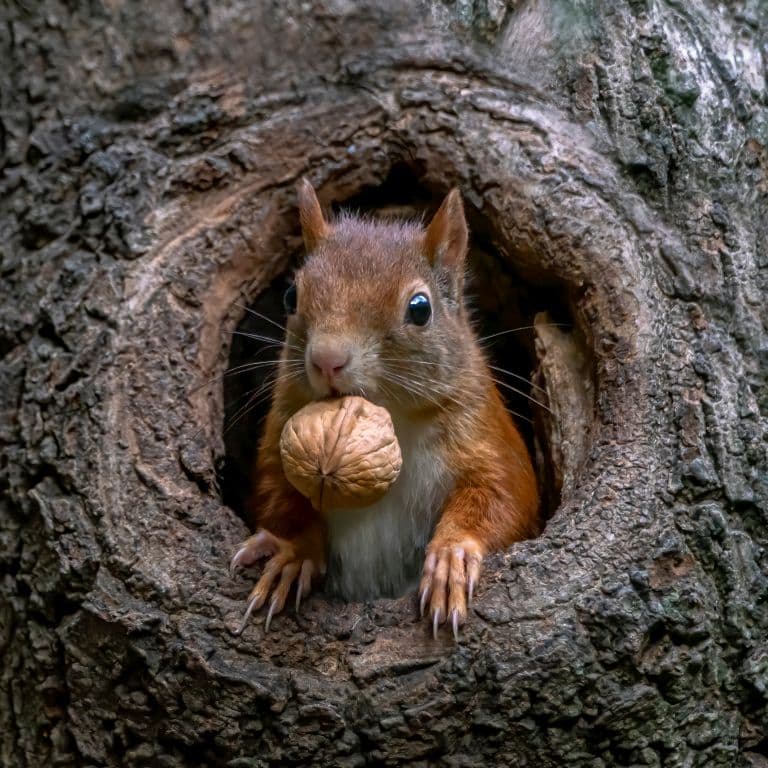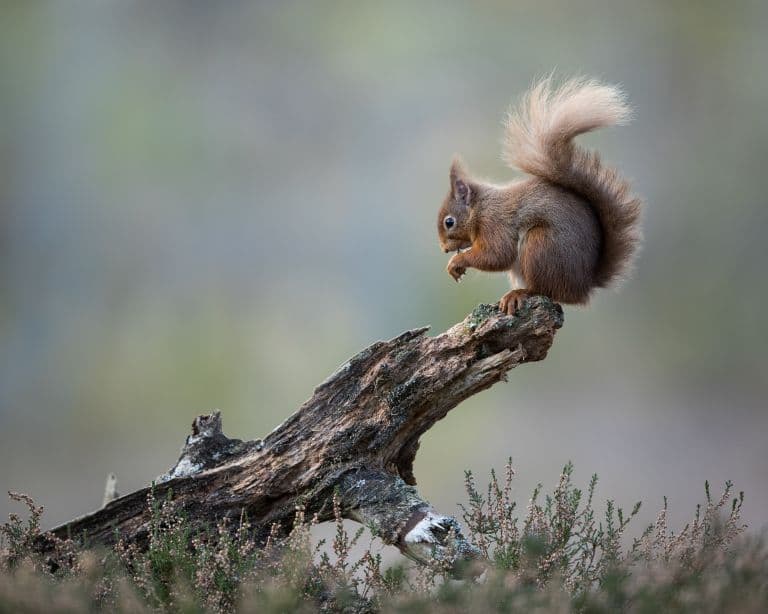Red Squirrel Profile
Countries love to pick a national animal that’s revered for its ability to kill things, but Denmark, arguably one of the best countries in the world as long as you don’t ask the Swedes, has chosen a far humbler champion.
One that represents a legendary messenger. Sharp-witted and cunning; small, yet remarkably successful. And in Norse mythology, this animal, the red squirrel, would carry messages from the top of the world tree to those dwelling beneath its roots.

Red Squirrel Facts Overview
| Habitat: | Deciduous and Coniferous forests |
| Location: | Northern Europe and Siberia |
| Lifespan: | 7-12 in the wild, 10-12 in captivity |
| Size: | 23cm (9 inches) long with a 20cm (8-inch) tail |
| Weight: | Up to 600g (21 oz), often half that. |
| Colour: | Varied, from light to dark reds; melanistic variants; all white creamy chests |
| Diet: | Seeds, fungi, nuts, birds’ eggs, and garden flowers and vegetables |
| Predators: | Pine martens, wild cats, stoats, raptors |
| Top Speed: | Nimble |
| No. of Species: | 1 |
| Conservation Status: | Least Concern (IUCN) |
Red squirrels are found all over Europe and Siberia, with a very threatened population in Britain. They are an arboreal rodent and live in forests and woodlands. They are found in conifers, Pines, Spruces and broadleaf trees where they can make nests our of twigs.
They are primarily herbivorous and will eat the seeds of trees, nuts, berries, flowers and shoots. They may also eat birds eggs and nestlings.
While the tragedy of their decline in the UK will take some serious work to reverse, it’s also a great opportunity to learn about why biodiversity is important and how to prevent this from happening elsewhere.
These cute little tree specialists are responsible for a lot more than meets the eye in the forest communities that look after them.
Interesting Red Squirrel Facts
1. They’re tree specialists
This might be thought of as a given for a squirrel, but there are quite a few species that don’t spend nearly as much time in the trees as this one.
The Eurasian red squirrel is quite a lot different from the North American red squirrel, which, while in the same family is a different genus than both the Eurasian red and the invasive American gray squirrels. Both are tree squirrels, but neither is quite as adept at the tree part as the Eurasian red.
Their agility, small size and insatiable hunger for nuts keep this species up in the canopy, where they’re safer from predators. This is also the key to their ecological significance and their rehabilitation in the UK, as we’ll see shortly.

2. They are nutty about nuts
Food is at the top of the priority list for a red squirrel. They are about as stereotypically into nuts as you can get, and spend all morning and evening collecting and eating these treasures.
They build lovely messy twig nests, known as dreys, at the fork of a branch, and they spend much of the Spring and Summer midday periods resting in these, waiting for the heat to die down. They usually spend this time alone, as they’re quite shy, but sometimes during Winter they’ll cuddle up and share one for extra warmth.
Winter is no time for a siesta, and the whole day is spent foraging, though the day is shorter, overall.
The vast majority of their time is spent in the canopy, but these are also seed buriers, and forgetful ones, which is one of the key reasons they are so significant. 1
3. They plant trees
Being such prolific seed gatherers, there are always stashes they forget, and we all know from Stardew Valley what happens when you bury a seed and forget about it: eventually, it grows.
So, the red squirrel is about as direct an ecosystem engineer as you can get, routinely taking mature seeds and planting them into the soil, no doubt sometimes accompanied by a nutritious dropping or two for luck.
Seed dispersal is incredibly important to forest communities, as it keeps the offspring of trees from growing too close together and becoming inbred. So, squirrels are important to the health of their ecosystems.
4. They have a tough life
Despite their significance, nature is a harsh and indifferent mistress and the chances of success for a red squirrel at birth are slim.
Up to 85% of juveniles may not survive their first Winter, and their success is determined by how well their parents remember where they’ve stashed the seeds, and of course the abundance of seeds in the first place.
Those few who make it past the first Winter are not out of the woods, either. They have a life expectancy of only 3 years, though when well protected and looked after they have a natural life span of up to 10.
Each Winter after the first carries with it a 50% chance of death. 2
5. They are thankful to woodpeckers
One way to conserve energy and improve your chances as an over-wintering animal is to find a nice shelter that someone else built.
Woodpeckers are excellent help at this, and the hollows they make in trees are often accommodated by the squirrel. 3

6. They are suffering from habitat fragmentation
Another key to their success is the health of their habitat, and this is something that is worrying decaying in much of the world.
Woodlot size and isolation are drivers of red squirrel reproductive success, meaning that the larger the forest and the better connected it is, the higher the chance the baby squirrel has to survive its first Winter.
And nowhere in Europe is the forest as small and fragmented as it is in the UK.
7. They’re dangerously reduced in the UK
These little squirrels were once everywhere in Britain, and now have been pushed up to the extreme North of England where the people are remarkably friendly but you can’t understand a word they’re saying.
They are still widespread in Scotland, but even grouped together they are a fragment of their former glory.
The lack of habitat is of course a major problem but so is the invasion of the American grey squirrel, which, while not directly violent to the red, brings pox with it, and eats all the nuts.
While Britain once boasted 3.5 million red squirrels, the population of red squirrels in England has now dropped to only 40,000, with 120,000 in Scotland.
This carnage by the gray squirrel is mostly isolated to Britain but threatens to spread to Europe, where communities of the invader are slowly spreading. 4

8. Pine martens to the rescue!
Another animal that was once eradicated from the ‘Isles may hold the key to red squirrel conservation.
The pine marten has begun its journey to recovery in Britain after concerted efforts to reintroduce and then protect the once-native predator in parts of its previous range.
Interestingly, this predator of the red squirrel has set to work hunting and killing the gray squirrel, who is not only fatter and slower than its European cousin but also spends a lot more time on the ground, where it’s easier to catch. 5
9. This is why biodiversity is important!
Ecologists and conservationists talk a lot about biodiversity, and for good reason, though these reasons aren’t always as obvious as with the case of the red squirrel and the pine marten.
Biodiversity is so much more than just having a range of cute animals to look at. It’s the fundamental driver of resilience across the entire ecosystem, and it’s on full display here with the red squirrel.
The pine marten and the red squirrel are, by all accounts, mortal enemies. But by removing the pine marten from the equation, the red squirrel suffers far greater threats in the long run.
But with the introduction of the grey squirrel, the population was almost wiped out from Britain, it becomes almost ironic that bringing back the native marten is what created a buffer of protection for the red squirrel.
With the red squirrel populations on the rise, more trees are planted by their cached seeds. More trees mean more insects, birds, mammals, and the cascade of wildlife that comes from all of these things.
So, the message becomes clear here: the more native organisms are present, the more resilient to change their ecosystem becomes. Any addition or removal can, to an extent, be compensated for by what’s already there, as long as it is robust, or diverse, enough.
And conversely, this is why low biodiversity is so dangerous. A single tweak in the system; a single pregnant grey squirrel, riddled with squirrel pox; or a raccoon or domestic cat on an island where all the predators have been eradicated, and the entire ecosystem is uniquely vulnerable to collapse.
And this concept extends well beyond the cute fluffy mammals, down into the invertebrate communities that pollinate our crops, the microbes that process our fertile soils, and even the flora that comprise our gut and skin microbiota and keep us healthy.
The stability of each of these ecosystems benefits profoundly from a rich diversity and consequently, the respective crop monocultures, toxic fertilizers, and reckless antibiotic use have threatened them significantly.
Repopulating ecosystems that the human species have ravaged is the key to many of the ecological and even climate issues we are now facing as a result, and this is precisely why conservationists are always harping on about biodiversity.
Eurasian Red Squirrel Fact-File Summary
Scientific Classification
| Kingdom: | Animalia |
| Phylum: | Chordata |
| Class: | Mammalia |
| Order: | Rodentia |
| Family: | Sciuridae |
| Genus: | Sciurus |
| Species: | Sciurus Vulgaris |
Fact Sources & References
- J. M. TONKIN (1983), “Activity patterns of the Red squirrel (Sciurus vulgaris)”, Wiley Online Library.
- L. Wauters (1992), “Activity budget and foraging behaviour of red squirrels (Sciurus vulgaris) in coniferous and deciduous habitats”, Zoological Society of London.
- B. Verboom (1990), “Effects of habitat fragmentation on the red squirrel, Sciurus vulgaris L.”, Springer Link.
- “Red squirrel conservation”, UK Squirrel Accord.
- “Pine Marten”, British Red Squirrel.
